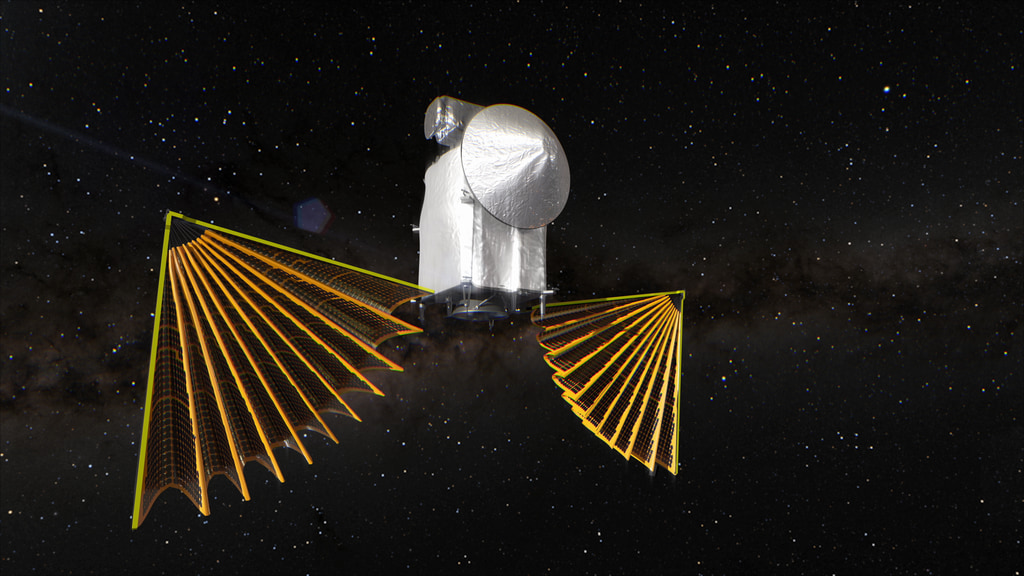NASA's Lucy asteroid probe settles into Earth-orbiting cruise as engineers tackle solar array glitch
The spacecraft is still safe as engineers examine the issue.

Days after NASA's new mission to a mysterious group of asteroids launched, spacecraft personnel continue battling an issue with one of the vehicle's two massive solar arrays.
The Lucy spacecraft is designed to fly by eight different asteroids, most of them Trojans that circle the sun in the same orbit as Jupiter but ahead of or behind the massive planet. To complete that task, it will rely on two solar arrays, each more than 24 feet (7 meters) across. But when the spacecraft deployed the arrays after launch on Saturday (Oct. 16), only one appeared to have properly latched.
Since then, mission personnel have been working simultaneously to assess the second solar array and to complete the unrelated tasks Lucy needs to accomplish at this point in its journey. In a statement released Tuesday (Oct. 19), NASA officials emphasized that the spacecraft can continue operating with the solar arrays as they are currently deployed and that the glitch isn't the end of the road for Lucy's mission.
Related: Meet the 8 asteroids NASA's Lucy spacecraft will visit
"The team continues its assessment and an attempt to fully deploy the solar array is planned no earlier than the end of next week," NASA officials wrote in the statement.
Engineers knew all along that the deployment process, which began about an hour after launch and took about 20 minutes to complete, would be challenging.
"During deployment, there are literally thousands of tiny little mechanisms and flexures that are deploying those wings like a Chinese fan," Katie Oakman, Lucy structures and mechanisms lead at Lockheed Martin Space, which built the spacecraft, said Thursday (Oct. 14) during a prelaunch news conference.
Breaking space news, the latest updates on rocket launches, skywatching events and more!
And it seems that on one solar array, one of those steps didn't quite go to plan. "Analysis currently shows the second solar array is partially unfurled," NASA officials wrote in the statement.
However, mission personnel are still working to determine precisely how open the troublesome array is. "The team continues to look at all available engineering data to establish how far it is deployed," the statement continues. "That solar array is generating nearly the expected power when compared to the fully deployed wing. This power level is enough to keep the spacecraft healthy and functioning."
That's not surprising, since Lucy's arrays are designed to power the spacecraft on much less sunlight than it's currently receiving. At Jupiter's orbital distance from our star, the sunlight is about 25 times weaker than what we experience near Earth, according to NASA.
"When we're near Earth, those wings have about 18,000 watts of power, so that would be equivalent to powering up my house and a couple of my neighbors," Oakman said during the news conference. "However, when we fly out to the Jupiter Trojan asteroids, we only have about 500 watts of power, so that would only light a few lightbulbs in my living room and it wouldn't be enough to power up my microwave in the morning to warm up my coffee."
She also noted that the instruments on Lucy can gather data during its flybys while using just 82 watts of power.
As the mission team continues to evaluate the state of the second solar array, engineers are working on other post-launch tasks as well.
The spacecraft entered cruise mode on Tuesday to give Lucy necessary "increased autonomy and spacecraft configuration changes," according to the release. The spacecraft is also using its thrusters to make small adjustments to its momentum.
And in a victory for the mission, the team determined that a backup trajectory correction maneuver isn't necessary, as the spacecraft is precisely where it needs to be, letting the team wait until mid-December for the first such maneuver.
In a concession to the solar array situation, however, the spacecraft has not yet deployed its instrument pointing platform, which had been scheduled to occur about two days after launch.
The Lucy team isn't sure yet whether the incident will have "any long-term implications to other scheduled activities," the statement notes.
Email Meghan Bartels at mbartels@space.com or follow her on Twitter @meghanbartels. Follow us on Twitter @Spacedotcom and on Facebook.

Meghan is a senior writer at Space.com and has more than five years' experience as a science journalist based in New York City. She joined Space.com in July 2018, with previous writing published in outlets including Newsweek and Audubon. Meghan earned an MA in science journalism from New York University and a BA in classics from Georgetown University, and in her free time she enjoys reading and visiting museums. Follow her on Twitter at @meghanbartels.
